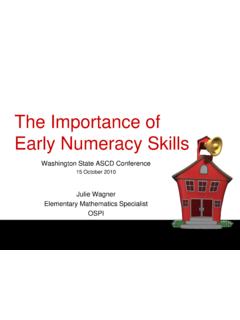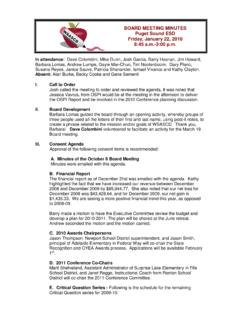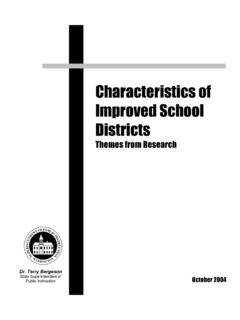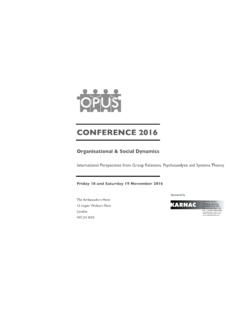Transcription of CONDUCTING THE CLASSROOM WALKTHROUGH 051509
1 CONDUCTING THE CLASSROOM WALKTHROUGH A Key Practice of Continuous school improvement Introduction The WALKTHROUGH process provides formative assessment data that answers the question, "How are we doing?" In regards to the implementation of standards-based teaching and learning. Examining and analyzing this data is a key to practice of continuous school improvement . The WALKTHROUGH Protocol outlined in this document provides a structure for consistent expectations across the district while allowing schools to address individual needs. This protocol is designed to document the expected outcomes of the school /districts focused professional learning and school improvement plans.
2 This process should be viewed as a non-threatening tool to stimulate professional conversations, as you raise expectations for all within a collaborative environment. Consistent and appropriate use of the tool will help to facilitate your journey to extraordinary performance. 5 Keys to Effective Walk Throughs Adopted from NSCD Step 1: Develop and use a common language for quality instruction. Work with faculty to identify key descriptors for the quality components of instruction and assessment. You can use a Protocol such as the Student Learning Protocol, Marzanos 9 High Yield Strategies, STAR or something created by the district to capture essential elements of best practices. Step 2: Establish clear and consistent expectations for the administrators' presence in classrooms and communicate these to your staff members and school community.
3 The principal is the instructional steward of the school and must model the expectations for the rest of the staff. Within the first week, visit every teacher's CLASSROOM and conduct multiple walk-through observations of the teachers you are evaluating. Other members of the leadership team are challenged to do the same. One practical tip: create a concise, user-friendly "walk through" form to expedite the process. Step 3: Schedule informal WALKTHROUGH observations as you would any other important item on your calendar. Establish a daily 30-minute commitment to being a visible presence in classrooms. Make the walk-through a part of the daily and weekly calendar, and incorporate it into your leadership team's routine.
4 Step 4: Use walkthroughs to promote dialogue with teachers. Use those coaching and feedback skills! The conversation that happens after the walk through is key to ensuring your walk throughs will result in changes in CLASSROOM practice. Walkthroughs are not just about affirming good or condemning poor instructional practices. Pose challenging, thought provoking questions to teachers based on what you see in classrooms. Promote reflection on best research-based practices and how they are used in the CLASSROOM . Step 5: Share anecdotal feedback from walkthroughs with your faculty. (See sample from Selah High school ) Anecdotal feedback, collected by the entire administrative team, forms an agenda for faculty meetings, staff development, or instructional council meetings.
5 Structure the learning environment for the adults to model the best practices you would like to see. WALKTHROUGH PURPOSE The purpose of the WALKTHROUGH is to: Give and receive safe, non-threatening, qualitative evidence-based feedback to stimulate in- school dialogue. Reinforce attention to a focus on teaching and learning priorities within a standards-based environment. Gather and provide qualitative data about instructional practice and student learning to supplement other data about school and student performance. Stimulate collaborative, professional conversations about teaching and learning through the gathering of evidence related to the instructional expectation/focus.
6 Learn from each other and from colleagues outside of the school through observing peers, asking questions, sharing experiences, and providing a variety of perspectives. Deepen an understanding of teaching and learning through ongoing, formative feedback related to school improvement that supports the school 's instructional focus. DESCRIPTION OF A WALKTHROUGH A WALKTHROUGH IS A .. Tool for school improvement that links effective practices with desired outcomes Process for giving and receiving non-threatening evidence-based feedback from colleagues to stimulate collaborative professional conversations Strategy for breaking down isolation and promoting collegiality Snapshot of an instructional focus within a school Format to move "private practice" into the public Arena A practice with confidentiality expectations A WALKTHROUGH IS NOT A(N).
7 Formal observation Audit Evaluation of individual teachers "Gotcha" opportunity for supervisors or peers Dog and pony show Isolated event Invitation to discuss inappropriately or gossip Benefits of the WALKTHROUGH Supports continuous school improvement Strengthens focus on teaching and learning Makes principals' presence in classrooms more frequent and more purposeful Aligns teachers and principals in terms of expectations Guides additional professional development Creates a common ground for discussing academic improvement Keeps the administrator "in-touch" with the day-to-day happenings in the CLASSROOM Enables principals to know teachers' strengths and Weaknesses Encourages the principal to be visible and to provide Feedback Reinforces the principal's vested interest in what goes on daily in school Improves rapport with students and decreases discipline Issues Increases appreciation by/of teachers Stimulates sharing within faculties about the effective practices and positive happenings in classrooms Provides for quality reflection on teaching and learning Leadership Innovations Team WORKING SAMPLES WALKTHROUGH FORMS CLASSROOM WALKTHROUGH Observation Form This form is used during the WALKTHROUGH to record artifacts and evidence that support the expectation.
8 CLASSROOM Walkthroughs are only effective when they are directly related to the expectations and practices of a specific school WALKTHROUGH focus areas should be developed by the school leadership team. Teacher: Grade/Subject: Observer: school : Date: Instructional Expectation/Focus of the WALKTHROUGH : (To be completed prior to WALKTHROUGH ) Question: Description: Artifacts: Tangible objects/documents in the CLASSROOM that are central to learning and help to substantiate the expectation-student work products; teacher produced materials. (Before assuming the artifact is not present, ask questions.): Check if Observed (To be completed prior to WALKTHROUGH ) Evidence: Observed behaviors of teachers/students that support the expectation (To be completed prior to WALKTHROUGH ) Evidence: Questions to students and/or teachers which show understanding of the expectation.
9 (To be completed prior to WALKTHROUGH ) (To be completed by Observer) 1. 2. 3. CLASSROOM WALKTHROUGH Observation Form This form is used during the WALKTHROUGH to record artifacts and evidence that support the expectation. CLASSROOM Walkthroughs are only effective when they are directly related to the expectations and practices of a specific school . WALKTHROUGH focus areas should be developed by the school leadership team. Teacher: Grade/Subject: Observer: school : Date: Instructional Expectation/Focus of the WALKTHROUGH : (To be completed prior to WALKTHROUGH ) Question: Description: Artifacts: Tangible objects/documents in the CLASSROOM that are central to learning and help to substantiate the expectation-student work products; teacher produced materials.
10 (Before assuming the artifact is not present, ask questions.): Check if Observed (To be completed prior to WALKTHROUGH ) Evidence: Observed behaviors of teachers/students that support the expectation (To be completed prior to WALKTHROUGH ) Evidence: Questions to students and/or teachers which show understanding of the expectation. (To be completed prior to WALKTHROUGH ) (To be completed by Observer) 1. 2. 3. CLASSROOM WALKTHROUGH Observation Form This form is used during the WALKTHROUGH to record artifacts and evidence that support the expectation. CLASSROOM Walkthroughs are only effective when they are directly related to the expectations and practices of a specific school .

![“The Practitioner’s Best Friend” www.wsascd.org Z] …](/cache/preview/f/c/d/b/f/3/5/9/thumb-fcdbf359eb2feebe2b0d0b5ec4c6aede.jpg)





